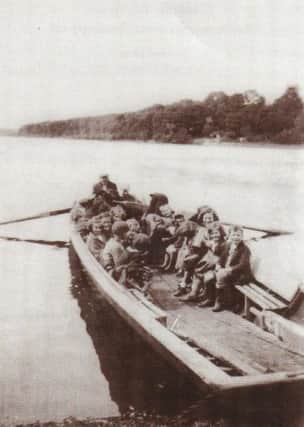Roamer: Sail of the century


Fermanagh-man Fred Ternan, the last child born on an island on Lower Lough Erne in 1949, shared his memories and stories about the long-gone days of the coité (wooden dug-out), the more recent wooden cots and the clinker rowing-boats that were once abundant on Lough Erne.
Mr Ternan’s family was one of the last islander-families who, like many thousands before them “were involved to some extent in almost every activity on Lough Erne” - a long tradition that Fred’s Lough Erne Heritage community organisation is exploring, preserving and regenerating.
Advertisement
Hide AdAdvertisement
Hide AdIn the past there was a whole culture around the cots, which were used for fishing, farming, leisure, drainage, general transport and the still ubiquitous school run.
Cot racing was particularly popular, vividly illustrated in an old letter printed in the now-defunct Enniskillen Chronicle and Erne Packet.
“It’s the earliest reference to cot racing I have been able to find,” Fred explained when he forwarded me the letter, dated 12 August 1824, published almost 200 years ago!
The eloquently over-written and occasionally obscure missive was about a forthcoming ‘grand nautical national’ with Donegal oarsmen competing against Fermanagh’s local cot racers.
Here are some colourful extracts:
Advertisement
Hide AdAdvertisement
Hide Ad“The stir visible amongst the seamen of the Lake assures a most interesting contest. To the amateur, the scene cannot fail to prove most interesting, as well from the unrivalled beauty of the sailing ground, as from the superiority of the boats, some of which, built on the Thames, are considered to be superior to any other vessels of any size, for lake sailing.
“The mariners of Donegal Bay will not, it is hoped, sleep on their oars; if rumour is to be credited, they are not to yield the palm so easily as they did last year.
“Boats are reported to be in readiness to invade the lake, from the sea, to assert the superiority of the Donegalian over his fresh-water competitor.
“Some experiments are to be tried upon scientific principles, where lightness of draught of water, and form, altogether differing from what, for centuries, has been in use, are to be put into competition with bulk and beam.
Advertisement
Hide AdAdvertisement
Hide Ad“The well-established speed of the Lough Erne cot is also to be tried, a boat being in preparation; these rivals to be pulled by Gentlemen of the Lake. Great confidence is expressed by the owners, and any money for hands with good beam and bottom. NB - Dandies not admitted.
“To cheer the toils of the seamen, two Balls are in contemplation, where all the rank and fashion of a wide extended country have engaged to attend.
“A very distinguished party from London, on a visit to the Lakes and Bundoran, will also be present, and gratify the eye, as they have already done in the mind’s eye of most of us.
“Besides the beauty of the Lakes, much speculation exists to account for their visit, whether an examination into the minerals and collieries of the neighbourhood, or the general capabilities of Lough Erne, an extension of the navigation, and perhaps a decision of a question which has long barred up our Lake - the choice between a canal to Lough Neagh and Belfast, or one from Ballyshannon.”
Advertisement
Hide AdAdvertisement
Hide AdBased on generations of island-family life on Lough Erne, a boating tradition that Fred Ternan and his colleagues are enthusiastically reigniting, Fred outlined the historical context of cot racing.
“There would have often been impromptu races,” he told Roamer, “anywhere where you had two boats or cots going in the same direction, a challenge would have begun by one boat pulling away from the other. The other vessel could not allow this to happen and so a race would have ensued. I often remember this happening when we lived on the lough.”
The earliest formal competitions probably began on yachts, with the landowners from big houses racing their more luxurious vessels during the summer months.
“Local people from the lough would have crewed such boats and would have travelled to the venue in their own cots,” recounted Mr Ternan.
Advertisement
Hide AdAdvertisement
Hide Ad“When the yacht or sailing-boat races were over, the crews from each boat were encouraged to race their cots for cash prizes put up by the sailing boat owners. The competitions would not only have been between the men rowing the cots but of course amongst the big houses for whom the cot men worked or on whose land they lived. Much would have been at stake! Legend has it that on the night before an important race in Enniskillen a racing cot was sabotaged by a person or persons unknown!”
A regatta was held every year from the 1880s with cash prizes for the winners of the races.
“This regatta had races for cots, boats, horses and bicycles,” Fred explained “though not all on the water might I add!”
The cots taking part had to be 24 feet long, or less, and the course was generally around a nearby island and back.”
“Cot racing continued into the 1930s on the Upper Lough on a course that was about a mile long, as it had been from the early 1800s,” Fred’s account concluded.